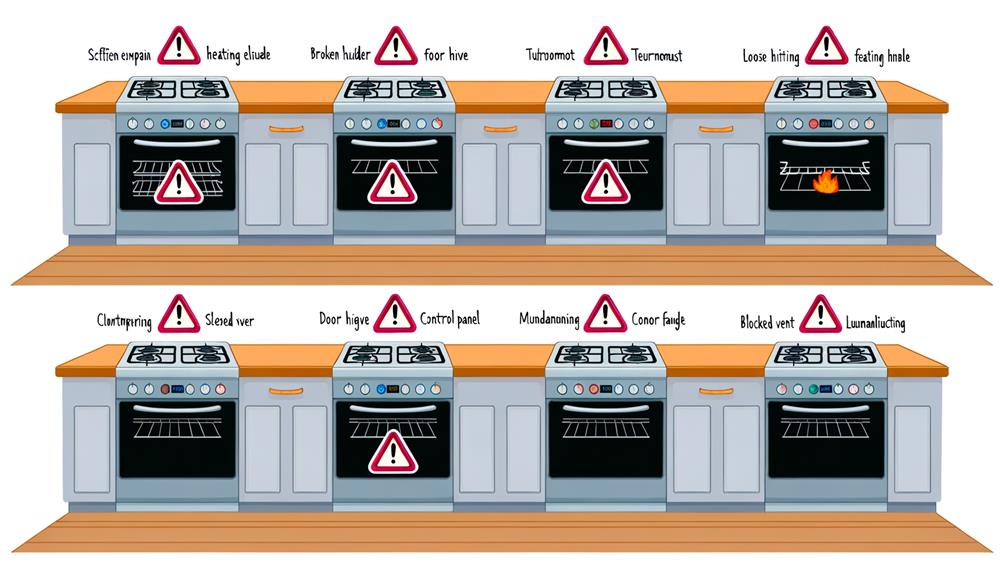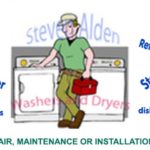
A stitch in time saves nine, and this couldn’t be truer when it comes to maintaining your oven. You’re often just one quick fix away from a perfectly baked pie or a flawlessly roasted chicken.
But when the heat’s on and your oven’s acting up, it’s crucial to know how to troubleshoot these common glitches. Whether it’s uneven heating, a door that won’t stay shut, or a fan that’s more silent than usual, you’ve got the power to nip these issues in the bud.
Let’s walk through six straightforward solutions that can keep your oven—and your kitchen routine—running smoothly. Stay with me, as I reveal how a simple adjustment or a quick component check can save your next dinner from disaster.
Troubleshooting Uneven Heating
If you’ve noticed your oven tends to cook unevenly, it’s time to tackle this all-too-common problem. Let’s start by checking the heat distribution in your oven. A practical tip is to rotate your baking trays halfway through the cooking time to help food brown evenly. If rotating doesn’t fix the issue, it’s likely your oven needs recalibration.
Just grab an oven thermometer, which is a simple tool for this task, and preheat your oven. Then, compare the temperature your oven displays with what the thermometer reads. If they don’t match, your oven’s manual should guide you on how to adjust the settings.
Keep in mind that the quality of your cooking impacts those you’re serving. So, it’s key to ensure your oven works as it should. By taking these steps, you’ll be on your way to enjoying perfectly cooked dishes every time.
Resolving Door Closure Issues
To get that perfect bake or roast, a consistent oven temperature is key, and that means having an oven door that seals properly. If you’re struggling with a door that won’t shut, you might be able to fix it with some simple maintenance. Often, oven door hinges become tight over time and prevent the door from closing completely.
To address this, apply a grease that’s safe for food contact to the hinges. As you move the door open and closed, the grease should help the hinge move more smoothly, and you’ll likely see an improvement right away.
Should greasing the hinges not do the trick, inspect the door latch. It may be out of alignment, which can interfere with the door’s seal. Simply loosen the screws that hold the latch in place, reposition it properly, and then retighten the screws.
By doing these straightforward tasks, you can help ensure that your oven door shuts tightly, keeping the heat inside where it needs to be for your cooking.
Remember: Regular maintenance of your oven door can’t only improve its function but can also extend the life of your appliance.
Fixing Faulty Ignition
If your oven won’t light, the problem might be a dirty or broken igniter. You need to either clean or replace it. Start by taking off the burner cap and grate and then use a toothbrush to gently clean the igniter, being careful not to break it. If that doesn’t fix the issue, your spark module might be the culprit, failing to send enough power to the igniter. If the spark seems weak, you may need to get a new one.
Ensuring your oven works well is important, especially when you’re cooking for others. With a clean or new igniter and a working spark module, you’ll be making hot meals for your loved ones again in no time.
Remember that keeping your oven in good condition isn’t just about the food; it’s also about safety. A well-maintained oven is less likely to have problems that could cause a fire or gas leak. So, take the time to inspect and clean your oven regularly. If you’re not sure how to replace a faulty part, don’t hesitate to call a professional. It’s better to be safe than sorry when dealing with appliances.
Addressing Temperature Inaccuracies
Moving beyond ignition issues, let’s tackle another common oven problem: temperature inaccuracies that can ruin your baking efforts. When your culinary creations aren’t turning out as expected, it’s likely your oven’s temperature is off.
You’ll want to start with temperature calibration, which is simpler than it sounds. Grab an oven thermometer and preheat your oven to a specific temperature. Once it’s heated, check the thermometer. If there’s a significant discrepancy, consult your oven’s manual for calibration instructions—it’s usually just a few button presses.
If calibration doesn’t solve the problem, you might be looking at thermostat replacement. It’s a more involved fix, but don’t be daunted. With the right tools and a bit of patience, you can restore your oven’s precision, ensuring your dishes are always cooked to perfection.
Clearing Obstructed Oven Fans
If your oven’s fan starts making unusual noises or your food isn’t cooking evenly, it may be time to check for and clear any obstructions. Proper fan maintenance is crucial to ensure your oven operates efficiently.
First, turn off and unplug your oven to ensure safety. Remove the racks to access the fan area easily. Gently clean the fan blades and surrounding components of any debris, using a soft brush or cloth. This can lead to noise reduction and restore even cooking.
Check for loose screws or parts that may cause the fan to wobble and tighten them. After clearing the obstructions, plug your oven back in and listen for any persistent noises before sliding the racks back in.
Regular checks can prevent future issues and keep your oven in top condition.
Replacing Worn Gaskets
A worn gasket can undermine your oven’s efficiency, so it’s essential to replace it promptly to maintain optimal performance. Begin with a thorough seal inspection to determine the state of your gasket. Look for cracks, tears, or areas where the gasket isn’t sealing properly. Gasket maintenance is key to ensuring your oven operates safely and effectively.
To replace the gasket, first, remove the damaged one by gently pulling it away from the door. If it’s fixed with screws or clips, use the appropriate tool to release it. Align the new gasket and press it firmly in place, securing any attachments as needed. Once installed, close the oven door to test the seal. A proper fit means better heat retention and more efficient cooking, serving your kitchen’s needs with excellence.
